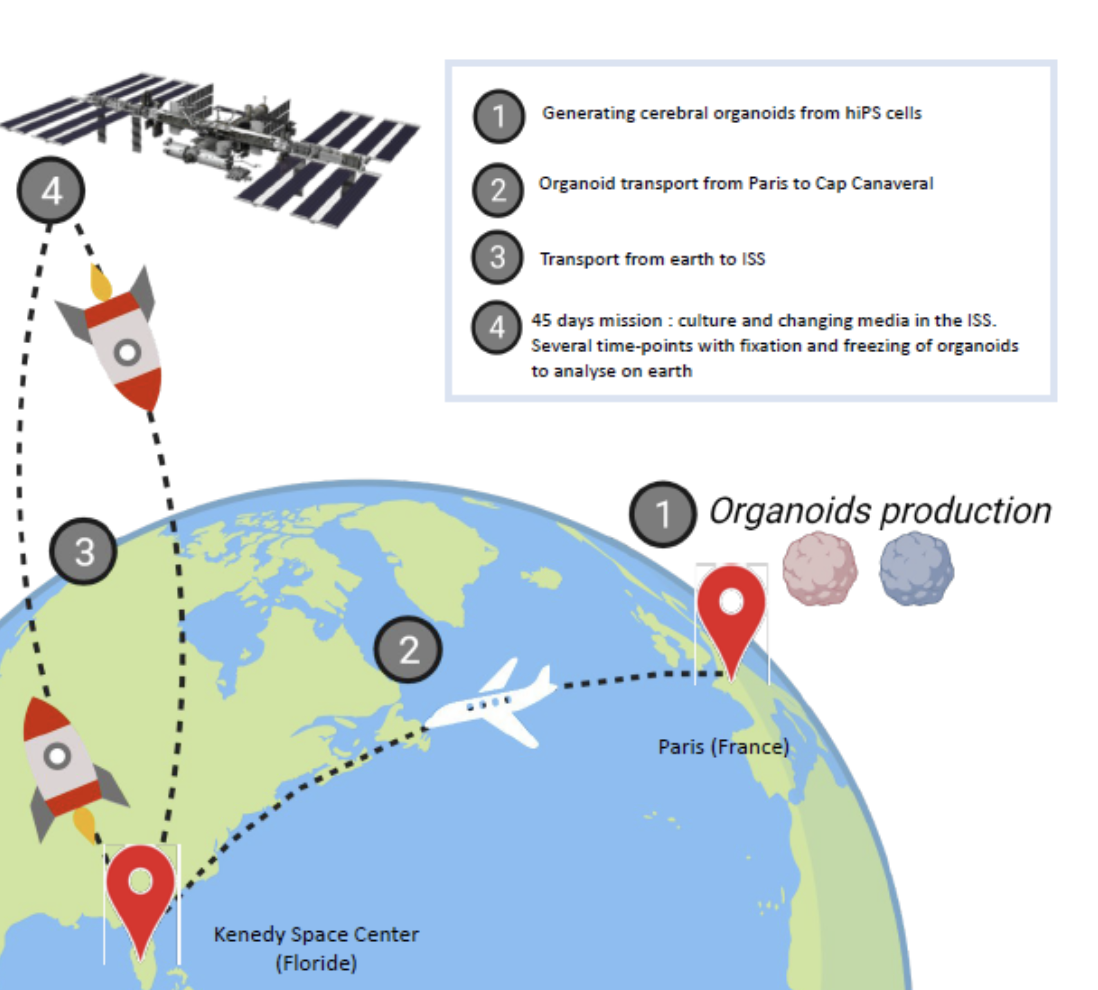August 2025

Biology in Orbit: How Cellbox™ Brings Life Science into Space
Written by: Robin Sieg & Prof. Dr. Kathrin Adlkofer
There is something profoundly captivating about the cosmos. For centuries, space has embodied the ultimate unknown and has fueled the imagination of scientists as well as dreamers and visionaries. What began as a geopolitical race to the moon has evolved into a global, multidisciplinary exploration of the last great frontier. In this era, biology and medicine have taken their place alongside physics, computer science, and engineering to uncover answers that may lie hidden among the stars. Microgravity, as it occurs during parabolic flights or orbital missions, is far more than just a spectacular backdrop. It is a valuable tool for studying life in its most fundamental forms:
On Earth, gravity is such a constant force that we rarely think about its impact. But when it is removed, its influence on physical and biological systems becomes very clear: In microgravity, boiling water behaves in unexpected ways: bubbles do not rise but instead float within the liquid or cling to the heating surface, governed purely by surface tension. Processes that seem entirely natural on Earth begin to follow unfamiliar rules in space, revealing challenges we would never encounter under normal conditions. For cellular systems, this means a fundamental change in their environment that goes far beyond merely altered physical conditions. Cell morphology, intracellular transport, gene expression, differentiation, and even cell-to-cell communication are shaped by mechanical stimuli. In the absence of gravity, the entire biological system is not only exposed to new physical conditions but must also be examined under entirely new premises.
This makes space an indispensable model for basic and applied life sciences. Without the overlapping influence of Earth's gravity, cell behavior, structure formation, and developmental processes can be studied in a much more isolated way. What starts as a simple observation of cell shape quickly leads to critical insights into development, pathology, or regeneration. Immune cells react differently. Tumor cells in vitro often behave more naturally in microgravity, similar to their behavior in the body. Stem cells, freed from sedimentation and weight, exhibit differentiation pathways that are hardly visible on the ground. Microgravity can help make essential variables more visible and simplify insights into complex processes.
However, conducting research under such sensitive conditions is anything but easy, as microgravity research brings with it significant logistical challenges. Unstable temperatures, vibrations during launch, pressure fluctuations, and long transport times to facilities such as the ISS or a parabolic aircraft pose considerable risks. The challenge lies not only in designing an experiment but in ensuring it reaches its destination biologically intact and reproducible, or even in accompanying it during the experiment itself.
This is where Cellbox™ comes into play, not as a simple transport container, but as an actively controlled incubator. Developed for use even during flight, Cellbox™ offers stable cultivation conditions throughout the entire logistical chain. Whether during a 30-hour transport to a spaceport or a short flight on a ZeroG aircraft, temperature and CO₂ levels remain constant. At the same time, an integrated data logging system continuously records parameters such as temperature, gas levels, tilt, and acceleration. This means that researchers receive not only their biological samples but also a complete dataset documenting the environmental conditions.
The value of this technology becomes clear in current research projects. During the 83rd ESA parabolic flight campaign, led by Tricia L. Larose, the project "Tumors in Space" transported patient-derived colon cancer organoids from HUB Organoids in the Netherlands to the Novespace flight center in Bordeaux. The organoids were actively cultured in the Cellbox™ not only during transport but also during the actual experiment, which involved 31 parabolas onboard the ZeroG flight.
The Cellbox™ served as a mobile laboratory, eliminating the need for stationary incubators or additional laboratory equipment on the aircraft, without sacrificing stable culture conditions. Continuous cultivation minimized potential distortion of biological data and enabled valid results directly from the flight profile. Our team accompanied the experiment from the lab to the return flight. A prime example of biology in motion under full control. The video documentation can be found here:
→ Read the full Interview with Prof. Asst. Gianluca Grenci
No video? Check your cookies or watch it on YouTube.
Similar applications can be found worldwide. One example is a collaborative project between Prof. Dr. Gianluca Grenci and Prof. Dr. Anne Beghin from the Mechanobiology Institute of the National University of Singapore, conducted in cooperation with the University of Zurich. Their research focused on how mechanical forces influence the development of 3D organoids during parabolic flights. In this study, they tested a novel cell culture system developed in-house: the “ZeroG Wells”, designed to produce, maintain, and analyze thousands of organoids under microgravity conditions.
These so-called “avatars” mimic the multicellular organization and basic functions of human organs and diseases and are used to investigate how altered gravity affects physiological and pathological processes, especially those associated with cellular aging. Micro-optical cell culture plates, optimized for confocal or light-sheet live imaging, ensured that organoids remained in a stable position throughout the experiment, minimizing motion artifacts. Once again, Cellbox™ provided the controlled environmental conditions required for meaningful scientific insight.
In another collaborative project with ARIS and the Institute of Oncology Research (IOR; Andrea Alimonti Lab), patient-derived cancer cell models were deliberately exposed to brief 0-g stimuli. Analyses, including RNA extraction, RT-qPCR, and FACS indicated reduced cell proliferation, modulation of the Hippo signaling pathway (cytoskeleton/proliferation), and activation of senescence pathways. Throughout transport and the experiment itself, Cellbox™ maintained stable culture conditions and provided synchronized environmental data for the analysis.
The Cerebral Ageing Mission: setting up the conditions to cultivatecerebral organoids in the International Space Station (ISS).

Another milestone was the transport of cerebral organoids for research into neurodegenerative processes. Developed by Sup'Biotech in Paris, they were brought to the launch site at Cape Canaveral using Cellbox™, to later begin a long-term study in orbit. Unlike conventional shipments that rely on cold chains or preservation, these organoids traveled in active culture. They were ready for use immediately upon arrival, with no need for thawing, washing, or regeneration. This was not only more convenient but also scientifically essential. A biological system that remains in homeostasis behaves more naturally.
In all these scenarios, Cellbox™ was far more than just a transport container. It protected sensitive cell cultures over thousands of kilometers, passed through transit stations, and withstood physical stress without compromising biological integrity. This meant that the samples not only reached their destination intact but also enabled valid scientific results from the outset. Researchers could trust that their experiments began, proceeded, and ended under stable conditions, an often underestimated prerequisite for reproducible findings.
Especially in the increasingly complex ecosystem of space biology, this level of reliability is indispensable. Every space mission initiates a chain of precisely planned logistical processes, from initial laboratory conception to transport to the launch site to implementation in microgravity. Whether Cape Canaveral or Bordeaux, every route is a balancing act between biological integrity, technical feasibility and costs. Cellbox™ bridges this gap by ensuring stable culture conditions throughout, meeting regulatory requirements, and integrating seamlessly into existing workflows.
This capability not only makes space research more robust but also more accessible. Cellbox™ is not exclusively aimed at large agencies or top research institutions but also opens up access to microgravity research for start-ups, mid-sized labs, and biotech companies. The more we learn about cellular behavior in space, the better we understand fundamental biological principles and their implications for the future of medicine. Cellbox™ is not a passive companion but an active tool that not only enables research but accelerates it. Our mission is to bring science wherever it promises new insights. Whether on Earth or beyond, we are ready to support your mission.

